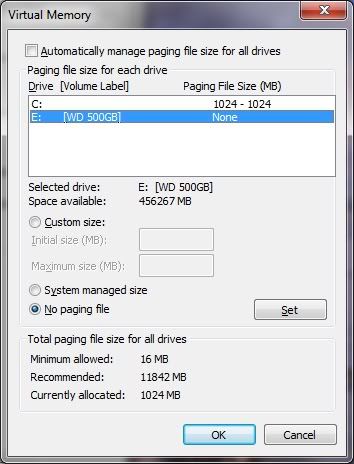I have just finished a new build with a Samsung 830 256 GB SSD for OS and some programs, a WD Caviar Black 500 GB secondary HDD for Data and other stuff and 8 GB DDR3 1600 SDRAM. I did most of the recommended Win 7 settings for optimizing use on a SSD.
New to SSDs so I did a fair amount of research on optimizing Win 7 for SSD. One recommendation was to reduce the Page File size. I have mine set to 1024 MB. Currently I show a No paging file option which is selected for the E drive (secondary drive) in the Virtual Memory configuration window. I did not set it that way.
I think the page file size for the SSD is OK for my usage but should I have a page file size set for the secondary HDD and if so what size would be recommended? System use is general, no gaming, some MS Office work, some Photoshop work (both of these will be installed on the SSD).


New to SSDs so I did a fair amount of research on optimizing Win 7 for SSD. One recommendation was to reduce the Page File size. I have mine set to 1024 MB. Currently I show a No paging file option which is selected for the E drive (secondary drive) in the Virtual Memory configuration window. I did not set it that way.
I think the page file size for the SSD is OK for my usage but should I have a page file size set for the secondary HDD and if so what size would be recommended? System use is general, no gaming, some MS Office work, some Photoshop work (both of these will be installed on the SSD).




 My secondary WD HDD probably should be partitioned. Very little on it now so I could just format it and start over with the type of partitioning you do. Still curious why the Virtual Memory settings were set with No page file. Is that normal for a non-OS drive?
My secondary WD HDD probably should be partitioned. Very little on it now so I could just format it and start over with the type of partitioning you do. Still curious why the Virtual Memory settings were set with No page file. Is that normal for a non-OS drive? and one swap file is fine for me. When I'm in my Virtual Memory configuration window, all of my partitions have the No Page File setting, except for my D: partition where I have it set to 1GB. You will have to see if your system can get by with 1GB. If you use hibernation, then windows should create a hibernation file that is probably the size of the amount of installed memory in your system and this file must be in the root directory of your boot partition and that this file can't be moved. Someone can correct me if I'm wrong. In some/many (most?) cases win7 does not require a page file that is as large as your installed memory. I've been using a 1GB page file in both of my systems for over five years. Both systems had 4GB of ram and I've been using 8GB of ram in my P35 system for almost two years. You can always use the min and max options to allow the page file to temporarily grow when needed. Some demanding or intensive games or programs might require a larger page file. I think that windows will rudely interrupt you if it runs out of virtual memory.
and one swap file is fine for me. When I'm in my Virtual Memory configuration window, all of my partitions have the No Page File setting, except for my D: partition where I have it set to 1GB. You will have to see if your system can get by with 1GB. If you use hibernation, then windows should create a hibernation file that is probably the size of the amount of installed memory in your system and this file must be in the root directory of your boot partition and that this file can't be moved. Someone can correct me if I'm wrong. In some/many (most?) cases win7 does not require a page file that is as large as your installed memory. I've been using a 1GB page file in both of my systems for over five years. Both systems had 4GB of ram and I've been using 8GB of ram in my P35 system for almost two years. You can always use the min and max options to allow the page file to temporarily grow when needed. Some demanding or intensive games or programs might require a larger page file. I think that windows will rudely interrupt you if it runs out of virtual memory.








 Took a look at DataRamDisk and it looks good. I think I'll try the ASRock fastRam utility that came with my board first and then if I don't like it try DataRamDisk. ASR fastRAM has dummy
Took a look at DataRamDisk and it looks good. I think I'll try the ASRock fastRam utility that came with my board first and then if I don't like it try DataRamDisk. ASR fastRAM has dummy 
Comment